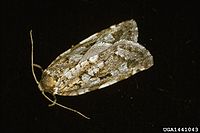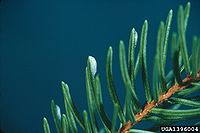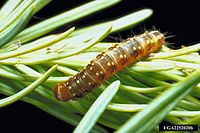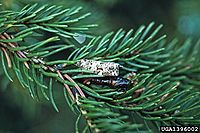- Spruce Budworm
-
Choristoneura 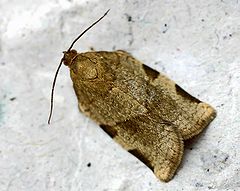
Mountain-ash tortricid
Choristoneura hebenstreitellaScientific classification Kingdom: Animalia Phylum: Arthropoda Class: Insecta Order: Lepidoptera Family: Tortricidae Subfamily: Tortricinae Tribe: Archipini Genus: Choristoneura
Lederer, 1859Species Several, see text.
Spruce budworms and relatives are a group of closely related insects in the genus Choristoneura. Most are serious pests of conifers. There are nearly a dozen Choristoneura species, subspecies, or forms, with a complexity of variation among populations found throughout much of the United States and Canada, and about again this number in Eurasia.
Contents
Species
- Choristoneura adumbratanus (Walsingham, 1900)
- Choristoneura africana Razowski, 2002
- Choristoneura albaniana (Walker, 1863)
- Choristoneura argentifasciata Heppner, 1989
- Choristoneura biennis Freeman, 1967
- Choristoneura bracatana (Rebel, in Rebel & Rogenhofer, 1894)
- Choristoneura carnana (Barnes & Busck, 1920)
- Choristoneura colyma Razowski, 2006
- Choristoneura conflictana (Walker, 1863)
- Choristoneura diversana (Hubner, [1814-1817])
- Choristoneura evanidana (Kennel, 1901)
- Choristoneura ferrugininotata Obraztsov, 1968
- Choristoneura fractivittana (Clemens, 1865)
- Choristoneura fumiferana (Clemens, 1865), Eastern Spruce Budworm
- Choristoneura griseicoma (Meyrick, 1924)
- Choristoneura hebenstreitella (Muller, 1764), Mountain-ash tortricid
- Choristoneura improvisana (Kuznetsov, 1973)
- Choristoneura jecorana (Kennel, 1899)
- Choristoneura jezoensis Yasuda & Suzuki, 1987
- Choristoneura lafauryana (Ragonot, 1875)
- Choristoneura lambertiana (Busck, 1915)
- Choristoneura longicellanus (Walsingham, 1900)
- Choristoneura luticostana (Christoph, 1888)
- Choristoneura metasequoiacola Liu, 1983
- Choristoneura murinana (Hubner, [1796-1799])
- Choristoneura neurophaea (Meyrick, 1932)
- Choristoneura obsoletana (Walker, 1863)
- Choristoneura occidentalis Freeman, 1967, Western Spruce Budworm
- Choristoneura orae Freeman, 1967
- Choristoneura parallela (Robinson, 1869)
- Choristoneura pinus Freeman, 1953, Jack Pine Budworm
- Choristoneura propensa Razowski, 1992
- Choristoneura quadratica Diakonoff, 1955
- Choristoneura retiniana (Walsingham, 1879)
- Choristoneura rosaceana (Harris, 1841)
- Choristoneura simonyi (Rebel, 1892)
- Choristoneura spaldingana Obraztsov, 1962
- Choristoneura thyrsifera Razowski, 1984
- Choristoneura zapulata (Robinson, 1869)
Western Spruce Budworm
Western Spruce Budworm is the most destructive defoliator of coniferous forests in Western North America. It is now widely distributed throughout the Rocky and Coast Mountains. The first recorded outbreak was in 1909 on the southeastern part of Vancouver Island in British Columbia, Canada. Since that year, infestations have frequently been reported in western Canada.[1]
The budworm was first recorded in 1914 in the United States, in Oregon. However, it was not initially recognized as a serious threat to coniferous forests in the western U.S. Aerial spraying apparently terminated some smaller epidemics in the southern and central Rockies; others subsided naturally. The insect then appeared to be dormant in US forests until 1922, when two outbreaks were reported near Priest Lake in northern Idaho. Since then, significant outbreaks in the Rockies and in the Pacific Northwest have caused top-killing and serious economic losses in tree growth. Tree mortality from budworm can occur in regeneration, sapling, and pole-sized trees. Trees in mature stands severely defoliated by the western spruce budworm may become susceptible to bark beetles, which kill mature trees.[1]
Considered the most destructive defoliator in British Columbia, sustained outbreaks of the Western Spruce Budworm resulted in defoliation of over 100,000 hectares (247,105 acres) in the Fraser Canyon - Lillooet - Pemberton area from 1949-58. From 1970 -2001 further outbreaks occurred over a much larger area including the area of the previous outbreaks, as well as the Thompson and South Okanagan areas in 1970-2001.[2]
There is no typical pattern for Western Spruce Budworm epidemics. Most of the early epidemics subsided naturally after a few years. Others persisted longer, but without spreading over large areas. An epidemic which began in 1949 in the northern Rocky Mountains has persisted for over 30 years despite insecticidal treatment of more than 6,000,000 acres (24,300 km²) between 1952 and 1966.[1]
Description
 Western Spruce Budworm caterpillar, sixth (final) instar
Western Spruce Budworm caterpillar, sixth (final) instar
Adult moths are about 1/2 inch (12.7 mm) long and have a wing-spread of 7/8 to 11/8 inches (22 to 28mm). Moths of both sexes are similar in appearance, although the females are a bit more robust than males. Both sexes fly. The gray- or orange-brown forewings are banded or streaked, and each usually has a conspicuous white dot on the wing margin. Eggs are oval, light green, and about 3/64 inch (1.2mm) long and overlap like shingles.
Larvae develop through six stages. Newly hatched larvae are yellow-green with brown heads. In the next three stages, larvae have black heads and collars and orange- or cinnamon-brown bodies. In the fifth stage, larvae have reddish-brown heads marked with black triangles, black collars, and pale olive-brown bodies marked with small whitish spots. Mature larvae are 1 to 11/4 inches (25 to 32 mm) long, with tan or light chestnut-brown heads and collars and olive- or reddish-brown bodies with large ivory-colored areas.
Pupae are 1/2 to 5/8 inch (13 to 16 mm) long, broad at the head end, and narrower toward the tail. They are brownish-yellow or brownish-green at first, and later turn reddish-brown.
Life History
Throughout most of its range, the Western Spruce Budworm completes one cycle of development from egg to adult within 12 months. Moths emerge from pupal cases usually in late July or early August; in the southern Rockies, adults often begin emerging in early July.
The adults mate, and within 7 to 10 days, the female deposits her eggs and then dies. Each female deposits approximately 150 eggs, usually on the underside of conifer needles. Eggs are laid in one to three-row masses containing a few to 130 eggs, with an average of 25 to 40 eggs per mass.
Larvae hatch from eggs in about 10 days. Larvae do not feed, but seek sheltered places under bark scales or in and among lichens on the tree bole or limbs. Here, they spin silken tents in which they remain inactive through the winter.
In early May to late June, larvae leave their hibernacula to search for food. They first mine or tunnel into year-old needles, closed buds, or newly developing vegetative or reproductive buds.
New foliage, which is normally the preferred food, is usually entirely consumed or destroyed before larvae will feed on older needles. Larvae become full grown usually in early July about 30 to 40 days after leaving their overwintering sites.
Larvae pupate in webs of silk they have spun either at the last feeding site or elsewhere on the tree. The pupal stage usually lasts about 10 days.
Eastern Spruce Budworm
The eastern version of the Spruce Budworm is Choristoneura fumiferana, which is one of the most destructive native insects in the northern spruce and fir forests of the Eastern United States and Canada. According to one common theory, popularized in the 1970s, periodic outbreaks of the spruce budworm are a part of the natural cycle of events associated with the maturing of balsam fir. The catastrophe theory of budworm outbreaks holds that particularly major infestations occur every 40–60 years, as the result of a cusp-catastrophe event, whereby populations jump suddenly from endemic to epidemic levels. An alternative theory holds that outbreaks are the result of spatially synchronized population oscillations that are caused by delayed density-dependent feedback (from various mortality agents) which are synchronized via a process of entrainment.
The first recorded outbreak of the spruce budworm in the United States occurred in Maine about 1807. Another outbreak followed in 1878. Since 1909 there have been waves of budworm outbreaks throughout the Eastern United States and Canada. The States most often affected are Maine, New Hampshire, New York, Michigan, Minnesota, and Wisconsin. These outbreaks have resulted in the loss of millions of cords of spruce and fir. In 20th century eastern Canada, the major outbreaks occurred in the time periods ~1910-20, ~1940-50, and ~1970-80. Longer-term tree-ring studies suggest that spruce budworm outbreaks have been recurring every three decades or so since the 16th century. Paleoecological studies suggest the spruce budworm has been outbreaking in eastern North America for thousands of years.
Balsam Fir is the species most severely damaged by the budworm in the Eastern United States. White, Red, and Black Spruce are suitable host trees and some feeding may occur on tamarack, pine, and hemlock. Spruce mixed with Balsam Fir is more likely to suffer budworm damage than spruce in pure stands.
The range of the spruce bud-worm includes the Northern States east of Montana but the budworm is found wherever host species grow.
Controls
Budworm populations are usually regulated naturally by combinations of several natural factors such as insect parasites, vertebrate and invertebrate predators, and adverse weather conditions. During prolonged outbreaks when stands become heavily defoliated, starvation can be an important mortality factor in regulating populations.
This species is a favoured food of the Cape May Warbler, which is therefore closely associated with its host plant, Balsam Fir. This bird, and the Tennessee and Bay-breasted Warblers, which also have a preference for budworm, lay more eggs and are more numerous in years of budworm abundance.
Natural enemies are probably responsible for considerable mortality when budworm populations are low, but seldom have a regulating influence when populations are in epidemic proportions.
Chemical insecticides such as malathion, carbaryl, and acephate can substantially reduce budworm. Microbial insecticides such as the bacterium Bacillus thuringiensis, a naturally occurring, host-specific pathogen that affects only the larvae of lepidopterous insects is environmentally safe to use in sensitive areas such as campgrounds or along rivers or streams where it may not be desirable to use chemical insecticides.
Appearances in the Media
In the Katharine Hepburn/Spencer Tracy film Desk Set, the market cost of the annual depredations of the Spruce Budworm on United States forests is invoked as an example reference question in comparing the response times of human reference librarians and early computer databases.
External links
Notes
- ^ a b c Fellin, D. and J. Dewey (March 1992). Western Spruce Budworm Forest Insect & Disease Leaflet 53, U.S. Forest Service. Retrieved on: September 14, 2008.
- ^ Natural Resources Canada. Western spruce budworm. Conifer Defoliating Insects of British Columbia. Canadian Forestry Service. Retrieved on: September 14, 2008.
Categories:- Archipini
- Insect pests of temperate forests
Wikimedia Foundation. 2010.

